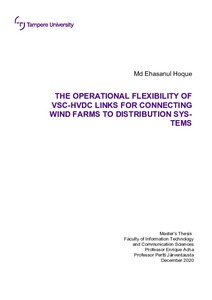The operational flexibility of VSC-HVDC links for connecting wind farms to distribution systems
Hoque, Md Ehasanul (2020)
Hoque, Md Ehasanul
2020
Master's Programme in Electrical Engineering
Informaatioteknologian ja viestinnän tiedekunta - Faculty of Information Technology and Communication Sciences
This publication is copyrighted. You may download, display and print it for Your own personal use. Commercial use is prohibited.
Hyväksymispäivämäärä
2020-12-23
Julkaisun pysyvä osoite on
https://urn.fi/URN:NBN:fi:tuni-202012219075
https://urn.fi/URN:NBN:fi:tuni-202012219075
Tiivistelmä
The penetration of renewable energy technologies (RES), electrical vehicles (EVs) and energy storage systems (ESS) into power systems is growing very significantly, aiming at obtaining CO2 free, ‘green’ energy. With the advent of modern, high-power solid-state semiconductor valves and bridges, the various power sectors (namely, generation, transmission and distribution) are undergoing rapid transformation, shifting towards hybrid AC-DC power grids. It is expected that such a transformation will enable higher grid stability, flexibility, voltage level independency and much improved power quality. To realise this, the use of voltage source converters-based HVDC (VSC-HVDC) links, particularly those geared towards the harnessing of the renewable energy resource, are receiving much attention.
The thesis focuses on power flow modelling and analysis where permanent magnet synchronous generator (PMSG) and squirrel-cage induction generator (SCIG) wind turbines are connected to a representative 5-node power system, using VSC-HVDC links. Several types of HVDC links are considered and the two-level VSC-HVDC link model is realized mathematically, in such a way that it is suitable for incorporation into a power flow formulation. Also, different types of wind turbines are studied, and mathematical models are developed to confirm some of the advantages offered by VSC-HVDC equipment to connect wind turbines into the power system. The Newton-Raphson power flow algorithm is adopted to perform the power flow calculations. MATLAB scripting is used to implement the developed mathematical models. Several test cases are studied using this MATLAB software.
The simulation results confirm that VSC-HVDC links do not only provide great flexibility in controlling active power flow but also in regulating voltage magnitude by either absorbing reactive power from the grid or by injecting reactive power into the grid.
The thesis focuses on power flow modelling and analysis where permanent magnet synchronous generator (PMSG) and squirrel-cage induction generator (SCIG) wind turbines are connected to a representative 5-node power system, using VSC-HVDC links. Several types of HVDC links are considered and the two-level VSC-HVDC link model is realized mathematically, in such a way that it is suitable for incorporation into a power flow formulation. Also, different types of wind turbines are studied, and mathematical models are developed to confirm some of the advantages offered by VSC-HVDC equipment to connect wind turbines into the power system. The Newton-Raphson power flow algorithm is adopted to perform the power flow calculations. MATLAB scripting is used to implement the developed mathematical models. Several test cases are studied using this MATLAB software.
The simulation results confirm that VSC-HVDC links do not only provide great flexibility in controlling active power flow but also in regulating voltage magnitude by either absorbing reactive power from the grid or by injecting reactive power into the grid.
